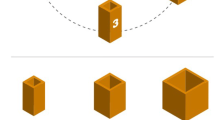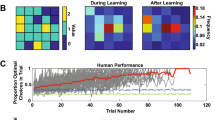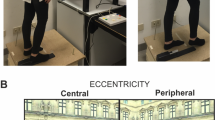Abstract
From birth, infants move their bodies in order to obtain information and stimulation from their environment. Exploratory movements are important for the development of an infant’s understanding of the world and are well established as being key to cognitive advances. Newly acquired motor skills increase the potential actions available to the infant. However, the way that infants employ potential actions in environments with multiple potential targets is undescribed. The current work investigated the target object selections of infants across a range of self-produced locomotor experience (11- to 14-month-old crawlers and walkers). Infants repeatedly accessed objects among pairs of objects differing in both distance and preference status, some requiring locomotion. Overall, their object actions were found to be sensitive to object preference status; however, the role of object distance in shaping object encounters was moderated by movement status. Crawlers’ actions appeared opportunistic and were biased towards nearby objects while walkers’ actions appeared intentional and were independent of object position. Moreover, walkers’ movements favoured preferred objects more strongly for children with higher levels of self-produced locomotion experience. The multi-target experimental situation used in this work parallels conditions faced by foraging organisms, and infants’ behaviours were discussed with respect to optimal foraging theory. There is a complex interplay between infants’ agency, locomotor experience, and environment in shaping their motor actions. Infants’ movements, in turn, determine the information and experiences offered to infants by their micro-environment.



Similar content being viewed by others
Notes
To ensure that these responses were not systematically biased, latency to first adult speech was coded for a subset (10 %) of infants tested. Occurrence of adult speech and latency to speak had no relationship with any of the study variables (all p > .4). Adult speech content was neutral following the instructions provided in training (e.g. “What’s in there?” and “You’re okay”).
References
Acredolo LP (1978) Development of spatial orientation in infancy. Dev Psychol 14:224–234
Acredolo LP (1990) Behavioral approaches to spatial orientation in infancy. Ann NY Acad Sci 608:596–612
Adolph KE, Cole WG, Komati M, Garciaguiree JS (2012) How do you learn to walk? Thousands of steps and dozens of falls per day. Psychol Sci 23:1387–1394
Andersson M (1981) Central place foraging in the whinchat, Saxicola rubetra. Ecology 62:538–544
Bremner JG, Bryant PE (1977) Place versus response as the basis of spatial errors made by young infants. J Exp Child Psychol 23:162–171
Brown JL, Orians GH (1970) Spacing patterns in mobile animals. Ann Rev Ecol Syst 1:239–262
Bushnell EW, Boudreau JP (1993) Motor development and the mind: the potential role of motor abilities as a determinant of aspects of perceptual development. Child Dev 64:1005–1021
Bushnell EW, McKenzie BE, Lawrence DA, Connell S (1995) The spatial coding strategies of one-year-old infants in a locomotor search task. Child Dev 66:937–958
Campos JJ, Anderson DI, Barbu-Roth MA, Hubbard EM, Hertenstein MJ, Witherington D (2000) Travel broadens the mind. Infancy 1:149–219
Campos JJ, Bertenthal BI, Kermoian R (1992a) Early experience and emotional development: the emergence of wariness of heights. Psychol Sci 3:61–64
Campos JJ, Kermoian R, Zumbahlen MR (1992b) Socioemotional transformations in the family system following infant crawling onset. NDCAD 55:25–40
Clearfield MW (2004) The role of crawling and walking experience in infant spatial memory. J Exp Child Psychol 89:214–241
Clearfield MW, Osborne CN, Mullen M (2008) Learning by looking: infants’ social looking behavior across the transition from crawling to walking. J Exp Child Psychol 100:297–307
Diamond A (1985) Development of the ability to use recall to guide action, as indicated by infants’ performance on AB. Child Dev 56:868–883
Gibson EJ (1988) Exploratory behavior in the development of perceiving, acting, and the acquiring of knowledge. Ann Rev Psychol 39:1–42
Horobin K, Acredolo L (1986) The role of attentiveness, mobility history, and separation of hiding sites on stage IV search behavior. J Exp Child Psychol 41:114–127
Karasik LB, Tamis-LeMonda CS, Adolph KE (2011) Transition from crawling to walking and infants’ actions with objects and people. Child Dev 82:1199–1209
Karasik LB, Adolph KE, Tamis-LeMonda CS, Zuckerman AL (2012) Carry on: spontaneous object carrying in 13-month-old crawling and walking infants. Dev Psychol 48:389–397
Karasik LB, Tamis-LeMonda CS, Adolph KE (2013) Crawling and walking infants elicit different verbal responses from mothers. Dev Sci 17:388–395
Kermoian R, Campos JJ (1988) Locomotor experience: a facilitator of spatial cognitive development. Child Dev 59:908–917
Krebs JR, Davies NB (1997) Behavioural ecology: an evolutionary perspective. Blackwell, Oxford
Kretch KS, Franchak JM, Adolph KE (2013) Crawling and walking infants see the world differently. Child Dev Adv Online Publ. doi:10.1111/cdev.12206
MacArthur RH, Pianka ER (1966) On optimal use of a patchy environment. Am Nat 100:603–609
McDonough L (1999) Early declarative memory for location. Brit J Dev Psychol 17:381–402
Piaget J (1954) The construction of reality in the child. Basic Books, New York
Pirolli P, Card SK (1999) Information foraging. Psychol Rev 106:643–675
Rosenbaum DA (2008) Reaching while walking: reaching distance costs more than walking distance. Psychon B Rev 15:1100–1104
Rosenbaum DA (2012) The tiger on your tail: choosing between temporally extended behaviors. Psychol Sci 23:855–860
Rosenbaum DA, Brach M, Semenov A (2011) Behavioral ecology meets motor behavior: choosing between walking and reaching paths. J Motor Behav 43:131–136
Sheya A, Smith LB (2010) Development through sensorimotor coordination. In: Stewart JR, Gapenne O, Di Paolo EA (eds) Enaction: toward a new paradigm for cognitive science. MIT Press, Cambridge, pp 123–144
Smith LB, Thelen E (2003) Development as a dynamic system. Trends Cogn Sci 7:343–348
Smith LB, Thelen E, Titzer R, McLin D (1999) Knowing in the context of action: the task dynamics of the A-not-B error. Psychol Rev 106:235–260
Sommerville JA, Woodward AL, Needham A (2005) Action experience alters 3-month-old infants’ perception of others’ actions. Cognition 96:B1–B11
Soska KC, Adolph KE, Johnson SP (2010) Systems in development: motor skill acquisition facilitates three-dimensional object completion. Dev Psychol 46:129–138
van der Meer AL (1997) Keeping the arm in the limelight: advanced visual control of arm movements in neonates. Eur J Paediatr Neuro 1:103–108
Acknowledgments
This work was supported by Ryerson University (to JPB) and by an Ontario Graduate Scholarship (to JAD). We would like to thank the infants and families that participated in this study as well as Melissa K. Edwards, Sandra V. Herrera, Natalia Kolis, Anastasiya Komkova, Leila Malone, Ansa K. Puttick, Shadi Sibani, and Christopher Szczechowicz for testing and video coding support and Quantel Wronski for creating the line drawing.
Author information
Authors and Affiliations
Corresponding author
Rights and permissions
About this article
Cite this article
Dosso, J.A., Boudreau, J.P. Crawling and walking infants encounter objects differently in a multi-target environment. Exp Brain Res 232, 3047–3054 (2014). https://doi.org/10.1007/s00221-014-3984-z
Received:
Accepted:
Published:
Issue Date:
DOI: https://doi.org/10.1007/s00221-014-3984-z




